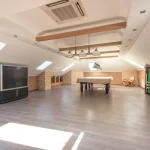As remote work continues to dominate the employment landscape, real estate prices in suburban and city fringe areas are experiencing dramatic shifts. This article will examine the impact of remote work on property prices, particularly in suburban areas.
The Shift to Remote Work
The shift to remote work has been on the rise over the last few years, with more people realizing the benefits of working from home. This trend is not just a passing phase; it represents a fundamental change in how we approach work and business.
Topic to read : What Strategies Can Maximize Retention Rates in Luxury Apartment Communities?
The COVID-19 pandemic served as a catalyst, accelerating the adoption of remote work across various industries. Companies that once held steadfast to traditional office spaces found themselves compelled to adapt to this new normal.
The shift to remote work has upended traditional office culture and altered the dynamics of the commercial property market. As more companies adopt flexible work policies, the demand for commercial office spaces in urban areas has dropped significantly.
Also to see : How to Navigate the Regulatory Landscape for Building Conversions in Conservation Areas?
Companies are downsizing their office spaces or forgoing them altogether, placing their focus on equipping their employees with the necessary tools to work from their homes. This has led to a decline in demand for commercial properties, impacting the real estate market significantly.
Impact on Suburban Real Estate
As people continue to embrace remote work, the urban flight is becoming more pronounced. People are leaving city centers, preferring suburban and city fringe areas where they can get larger living spaces for the same or even less cost.
Moreover, with the elimination of daily commutes, the need to live close to the office is no longer a factor for many. This shift in living preferences is fueling a boom in the suburban real estate market.
Suburban homes offer more space and privacy compared to city dwellings. These larger spaces are desirable for remote workers who require a dedicated home office area. As a result, there is increasing demand for suburban properties, which is pushing up housing prices in these areas.
The Future of the Real Estate Market
The remote work trend shows no signs of slowing down. As it continues to grow, its effects on the real estate market are likely to become more pronounced.
Suburban real estate is expected to remain in high demand as long as remote work remains prevalent. This could lead to a continued rise in suburban property prices.
However, it is not clear what impact this will have on urban real estate. There are predictions of a possible urban revival, particularly if companies decide to return to the office. Should this happen, there might be a renewed demand for urban properties, potentially stabilizing urban property prices.
How Real Estate Investors are Responding
Investors are watching these trends closely, recognizing the potential opportunities they present. Some are shifting their focus from commercial to residential properties, investing in suburban real estate where demand is high.
Investors are also exploring potential investment opportunities in co-working spaces. Though the demand for traditional office spaces is declining, there is an increase in demand for flexible workspaces where people can work remotely yet still have access to office-like amenities.
Adapting to the Changes
As the world continues to adapt to the new normal, so too must the real estate market. Property developers must rethink their strategies, considering the changing needs and preferences of homebuyers.
Space and location, once the prime selling points for urban properties, are no longer the main considerations. Now, homebuyers are seeking properties that offer the best of both worlds – the peace and tranquility of suburban living, coupled with the convenience of having an office at home.
In conclusion, the shift to remote work is reshaping the real estate market in ways we never anticipated. As we embrace this change, we must remain adaptable, responding proactively to the challenges and opportunities it presents.
The Implications for the Commercial Real Estate Industry
As the dynamics of the real estate industry adjust to the remote work trend, the commercial real estate sector is experiencing a significant shift. As more companies transition to remote or hybrid work models, the demand for traditional office spaces in urban areas has decreased. This shift has led to an increased availability of vacant commercial properties in city centers, creating a potential challenge for this sector of the real estate market.
However, this trend might also bring unexpected opportunities. With the rise in remote working, there is an increased demand for more versatile working spaces. People are starting to look for spaces that can provide a balance between working from home and working in a traditional office setting. This has led to a rise in demand for co-working spaces, offering flexible working solutions with office-like amenities.
In response, developers and investors in the commercial real estate industry are adapting their strategies. They are repurposing vacant office buildings into co-working spaces or even residential units. Some are also investing in improving the digital infrastructure of these properties, making them more attractive to tech-savvy tenants.
In many ways, the pandemic has fast-tracked the digitization of the commercial real estate industry. Virtual tours and digital transactions are becoming more commonplace, helping to keep the industry afloat during uncertain times.
Long-Term Impact and Future Perspectives
The long-term impact of remote working on the real estate industry remains to be seen. However, it is clear that this trend has set in motion a series of changes that are likely to continue to influence the industry for many years to come.
As remote work continues to be a norm, the preference for suburban and rural properties over city living is likely to persist. This could result in a sustained rise in suburban property prices, while urban areas may continue to see a decline in demand.
However, the potential for an urban revival should not be dismissed entirely. As the pandemic is brought under control and society begins to open up, companies may start to reintroduce office-based work, albeit in a hybrid model, leading to a potential resurgence in demand for urban properties.
Furthermore, the advancement in technology and the rise of autonomous vehicles can also change the dynamics of the real estate market. These developments can potentially make commuting less strenuous, making living in suburban areas more appealing.
In conclusion, the impact of remote work on real estate is profound, presenting both challenges and opportunities. The real estate market must continue to evolve and adapt to these changes. This involves not only responding to the current trends, but also anticipating future developments and preparing for them. As we navigate through these changes, one thing is certain: the real estate industry will never be the same again.











